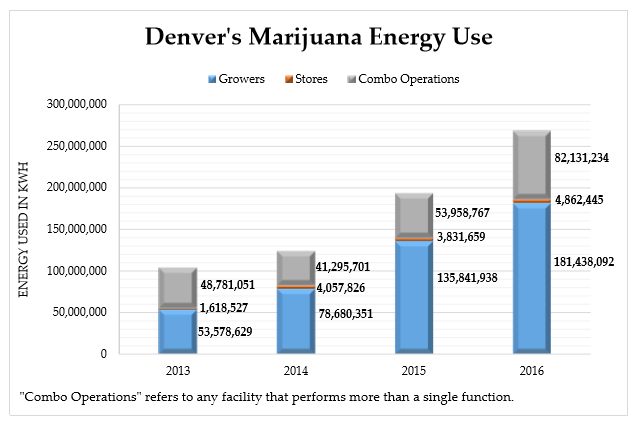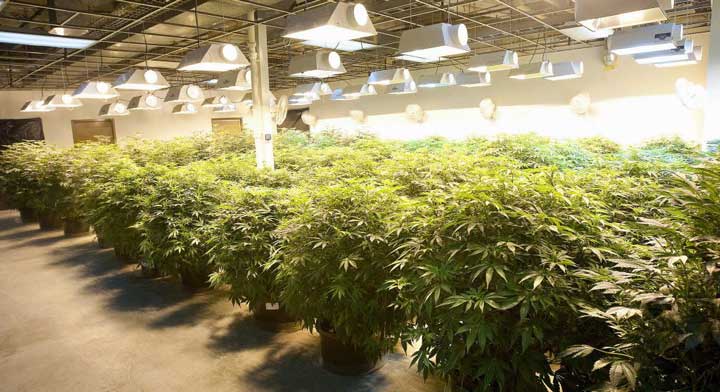 The full effects of the industry on the natural environment are only just beginning to be recognised. To grow around the clock requires intense lights that get very hot. To mitigate that heat, “grows” need fans and ventilation systems to clear the hot air.
The full effects of the industry on the natural environment are only just beginning to be recognised. To grow around the clock requires intense lights that get very hot. To mitigate that heat, “grows” need fans and ventilation systems to clear the hot air.
These impacts occur even under a so-called “regulated” environment, as the vast amounts of water and electricity needed to power marijuana farms are damaging to the environment. Because the black market for marijuana in legalised states like Colorado has not abated, abuse and degradation of public lands from illegal grows has continued.
ENERGY
In the US, much of marijuana’s environmental impact stems from the huge amount of light needed to grow plants indoors, where they can thrive year-round. Some growers power their giant “grow lights” with electricity from the grid.
- “Greenhouses are among the most thermally inefficient structures imaginable.”
- A theoretical hyper-greenhouse “uses 8-times as much electricity per square foot for lighting alone as the average U.S. office building uses for all purposes and 17-times as much as the average U.S. home.”
- “Carbon-intensive cannabis will continue to compound climate change unless an array of public policy strategies are assembled.”
Evan Mills, Ph.D. (energy analyst and building scientist, who is a Research Affiliate with the U.C. Berkeley’s Energy and Resources Group, 2018.
Marijuana is almost four times more energy intensive than oil or coal. It uses so much power that indoor marijuana production in Colorado is responsible for 2% of the state’s electrical load and 45% of all new electricity demand coming online. Mother Jones magazine indicated that the marijuana market “has placed a huge burden on the grid that distributes electricity throughout the state”. The marijuana industry went from 1.5 percent of overall Denver Electricity use in 2012 to nearly 4 percent in 2016.
In Canada, the energy munched by the fledgling cannabis-growing business is expected to rise by 1,250% in Ontario over the next five years, according to a recent study by the province’s Independent Electricity System Operator. At a projected 1.258 terawatt-hour (TWh) consumption by 2024, pot producers will suck up far more energy than the 0.8 TWh the province’s auto sector used in 2018.
Source: City and County of Denver, Xcel Energy, CPR, “Nearly 4 percent of Denver’s Electricity is now Devoted to Marijuana.”
CARBON FOOTPRINT
The energy to produce a single joint emits 3 pounds of carbon dioxide, which is comparable to leaving a TV on for over 15 hours.
“One average kilogram of final product is associated with 4600 kg of carbon dioxide emissions to the atmosphere.”
The carbon footprint of indoor Cannabis production – Energy Policy Journal
Experts says that burning one litre of diesel fuel releases about 2.6 kilograms of carbon; that works out to 1,769 litres of diesel fuel burned for every kilo of weed.
According to research published in the Journal of Environmental Science and Technology, cannabis cultivation consumes 5.2 MWh/y/kg of electricity and produces roughly 4.6 metric ton of CO2/kg of product.
WATER
Weed is water and power hungry. According to research published by the California Department of Fish and Wildlife, a mature cannabis plant can consume upwards of 22.7 liters of water per-day during the growing season – grape vines tend to use 12.64 liters of water per-day by comparison.
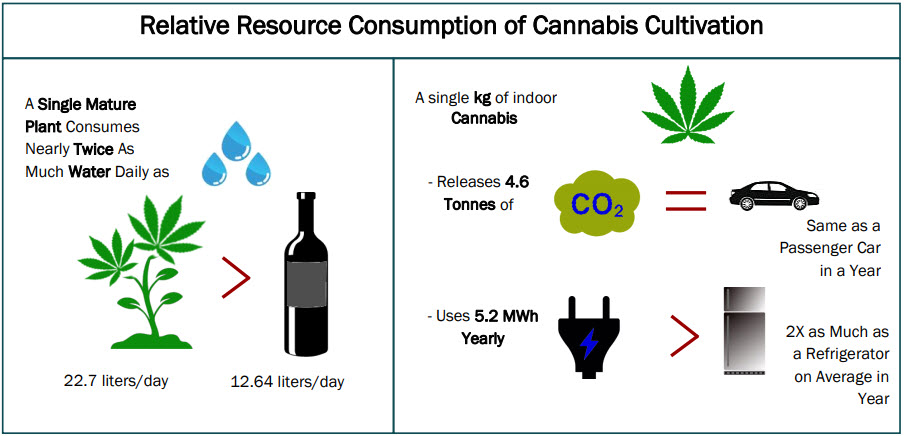
Source: An Initial Assessment of Cannabis Production, Distribution, and Consumption in Oregon 2018 – An Insight Report (Aug 2018)
https://www.epa.gov/greenvehicles
https://www.energystar.gov/most-efficient/me-certified-refrigerators
PESTICIDES
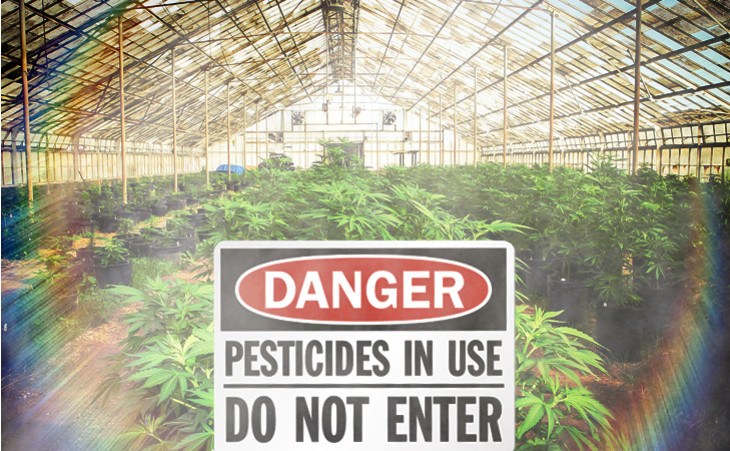 According to the Denver Post in 2015, when large numbers of cannabis plants are grown indoors and in close proximity, they are vulnerable to mites and powdery mildews, which can destroy a crop quickly. The Colorado Department of Agriculture (CDA) inspectors found two heavy-hitting pesticides — Floramite and Avid — were used on dozens of cannabis plants. Denver firefighters conducting routine safety inspections of marijuana growhouses in early 2014 discovered some growers were burning sulphur as a fumigant to kill mites. Once stopped from using the dangerous substance, the growers turned to pesticides, and firefighters noticed cabinets full of odd-sounding chemicals.
According to the Denver Post in 2015, when large numbers of cannabis plants are grown indoors and in close proximity, they are vulnerable to mites and powdery mildews, which can destroy a crop quickly. The Colorado Department of Agriculture (CDA) inspectors found two heavy-hitting pesticides — Floramite and Avid — were used on dozens of cannabis plants. Denver firefighters conducting routine safety inspections of marijuana growhouses in early 2014 discovered some growers were burning sulphur as a fumigant to kill mites. Once stopped from using the dangerous substance, the growers turned to pesticides, and firefighters noticed cabinets full of odd-sounding chemicals.
In December 2015, Denver-based marijuana company Advanced Medical Alternatives recalled 27 cartridges of its THC-infused vape pen oil due to potentially dangerous pesticides. The recall was the 13th issued by the department in 13 weeks. Advanced Medical Alternatives recalled a cannabis concentrate product that also had high levels of banned pesticides in the same month. The pesticide was myclobutanil which is used as a fungicide, but when heated, decomposes to produce corrosive and/or toxic fumes.
In 2016, two prominent Colorado cannabis businesses were forced to recall recreational marijuana because 16 batches tested positive for avermectin and 36 batches tested positive for spiromesifen.
And in California this year, pesticides, solvents and harmful bacteria have all been found lurking in marijuana products in California. Testing companies licensed by the state have found a small number of E. coli and salmonella cases. Researchers say nearly 20 percent of marijuana products have failed potency and purity tests.
According to researchers last year, 86% of California cannabis clones were contaminated. The study showed that only 14% of 124 randomly selected clones the firm tested showed no detectable pesticides. Many of the clones had more than one type of pesticide, with Myclobutanil as the most commonly detected one. An independent investigation in San Diego found that nearly 30% of marijuana samples purchased from 36 licensed retailers in Southern California lab-texted positive for pesticides (Grover & Corral, 2019).
Pesticide contamination has been an issue in Canada as well, with the regulator, Health Canada, implementing random testing after several voluntary recalls by licensed producers.
‘RAVAGING’ NATIONAL FORESTS
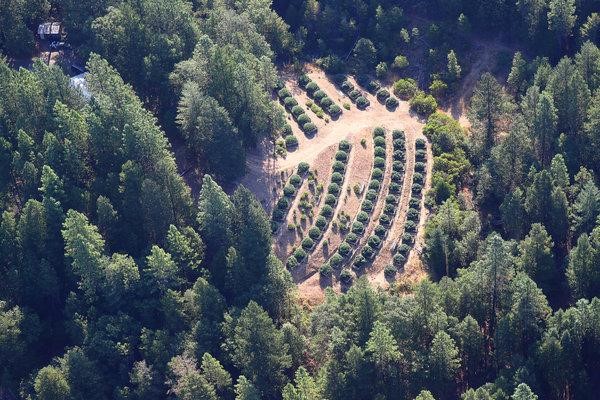 This year, it was reported that some of America’s most pristine forests are under assault by illegal marijuana cultivation and Federal narcotics agents destroyed more than 1.4 million marijuana plants and thousands of pounds of trash and numerous toxic chemicals were also removed in 2017. They say that growers have done more damage in the national forest by cutting down vegetation to plant the marijuana, and Enforcement teams also found what they feared: a bottle of carbofuran. The pesticide is banned in the U.S. which means it’s basically turned that area into a toxic waste dump. Just a small amount of the chemical can kill wildlife and further denigrate an area that includes a campsite filled with trash.
This year, it was reported that some of America’s most pristine forests are under assault by illegal marijuana cultivation and Federal narcotics agents destroyed more than 1.4 million marijuana plants and thousands of pounds of trash and numerous toxic chemicals were also removed in 2017. They say that growers have done more damage in the national forest by cutting down vegetation to plant the marijuana, and Enforcement teams also found what they feared: a bottle of carbofuran. The pesticide is banned in the U.S. which means it’s basically turned that area into a toxic waste dump. Just a small amount of the chemical can kill wildlife and further denigrate an area that includes a campsite filled with trash.

